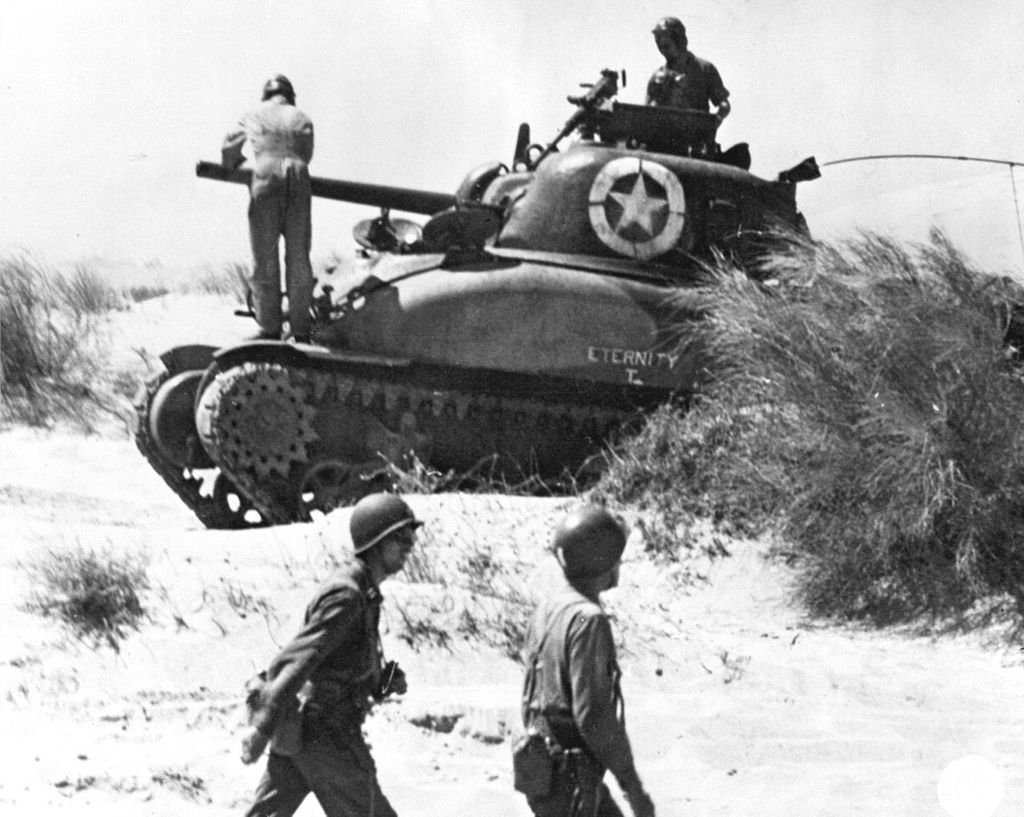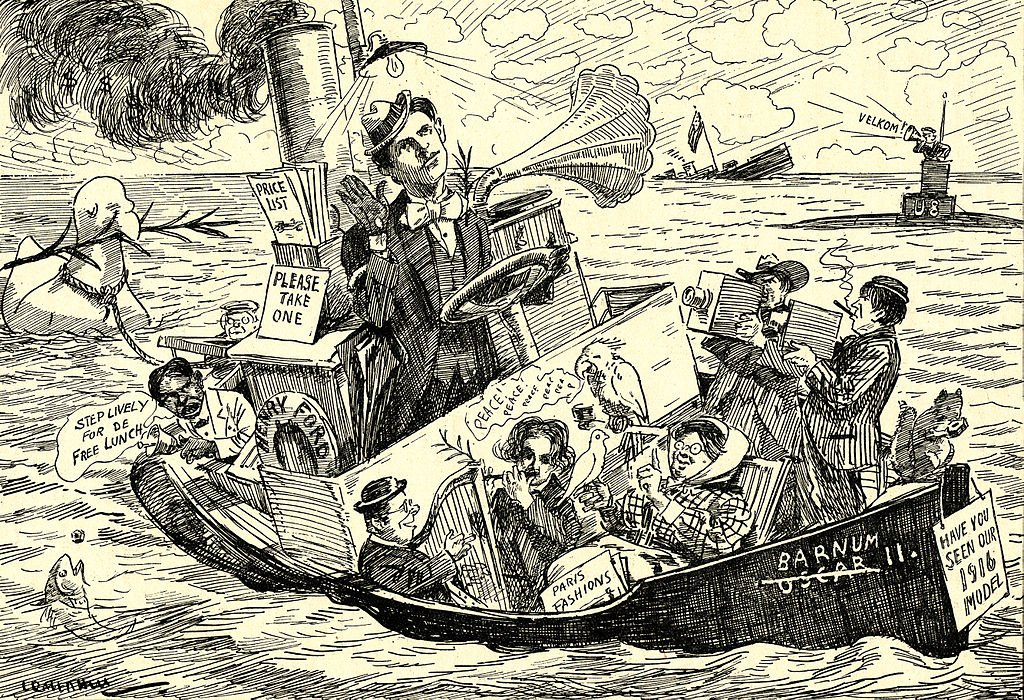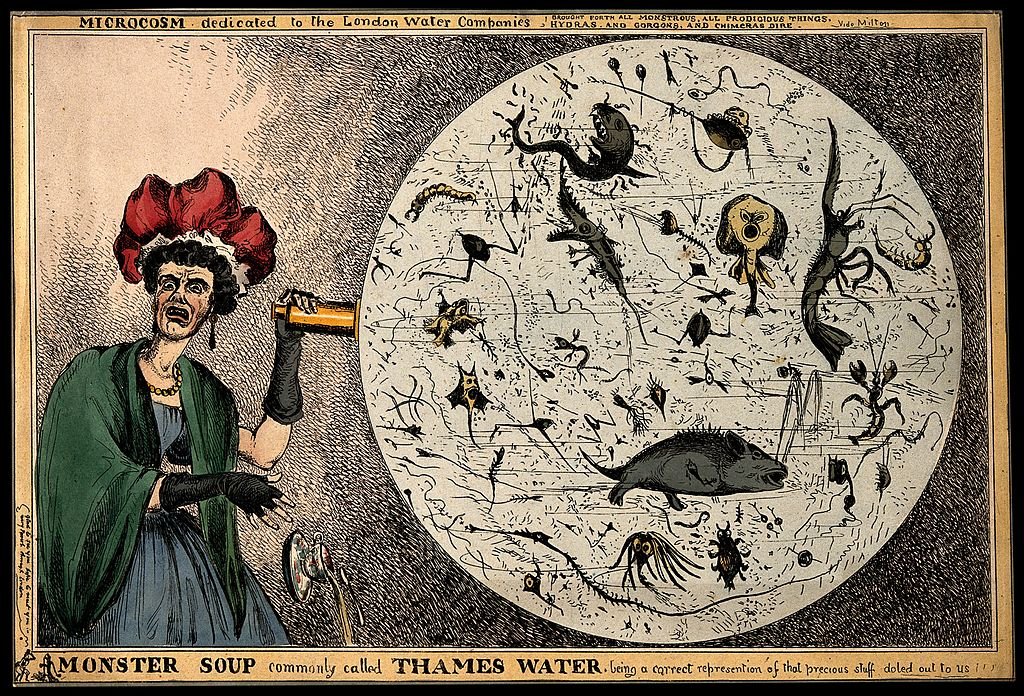American tanks and tank destroyers played an important role in the later years of World War 2. Here, Daniel Boustead looks at the most important of these tanks and the role they played in some key battles.
A Sherman tank during the Allied Invasion of Sicily in July 1943.
American Tanks and Tank Destroyers in World War II are very well known to the public and historians. The inferiority of these weapons was a direct result of government and U.S Army policies and doctrine. Extensive research has been done about the technical mediocrity of these weapons. The logistics and transportation of these weapons played a role in their technological inferiority. Very little could be done to improve the American Tank and Tank Destroyer’s marginal effectiveness. In contrast, Airpower and Artillery were the most effective Anti-Tank weapons.
At the end of World War I the U.S Military was trying to re arrange the peace time army. The Cavalry, Infantry, and Artillery branches of the U.S. Army viewed the Tank and the infant American Tank Corps as a threat and an encroachment to their turf and authority!. In 1919 General John J. Pershing (said in testimony before Congress) that the American Tank Corps “should not be a large organization”(1). General John J. Pershing also said (during his 1919 testimony) “it should be placed under the Chief of the Infantry as an adjunct to that arm”. Pershing’s testimony resulted in a significant event. In 1920, the U.S Congress passed the National Defense Act of 1920, which eliminated the infant Tank Corps. It also placed the Tank Corps under the Chief of Infantry as adjunct to that arm of the U.S. Army. This act seemingly destroyed any hopes for a future independent armored force. In October, 1931, the U.S. Army Chief of Staff Douglas MacArthur disbanded the “Mechanized Force”. He also ordered the Infantry and Cavalry branches to separately devise their own distinctive tanks and rules for their use(2). The resulting “Infantry tanks” would be used to accompany men on foot at a slow pace. In contrast, the light and under-gunned “Cavalry tanks” conducted reconnaissance and exploited enemy weakness. Mildred Gille said about General MacArthur’s decision, “When MacArthur saw fit to split the development of mechanization, the association of the two branches automatically resolved into an internecine competition for money, men and equipment”. The rivalry stifled any technological development in tanks. 3rd Armored Division member, Belton Cooper, recollected “As a young ordnance ROTC cadet in August, 1939, I was shocked to find that our total tank research and development budget for that year was only $85,000. How could the greatest industrial nation on earth devote such a pittance to the development of a major weapons system, particularly when World War II was to start in two weeks?”(3).
World War II
The M4 Sherman Tank was heavily influenced by the polices in 1942 from the Army Ground Forces Development Division (4) The Army Ground Forces Developmental Division had two primary criteria for a new weapon: “battle-need” and “battle-worthiness”.
“Battle-need” meant that the new equipment had to be essential, not merely desirable. This policy was articulated by. Lt. General Leslie McNair. McNair was insistent that the Army should not be burdened with too many weapon types since the U.S. Army would be fighting thousands of miles from the continental United States and could not afford to complicate logistics. As a result, the U.S Army was unwilling to adopt a specialized tank with heavier armor for the infantry support role.
“Battle-worthiness” meant that the design had to be capable of performing its intended function but to be sufficiently rugged and reliable to withstand the rigors of combat service without excessive maintenance demands.
The M4 Sherman Tank perfectly fit the criteria of “Battle-need” and “Battle-worthiness”. These policies of “Battle-need” and “Battle-worthiness” meant that the Army Ground Forces did not favor the development of new tanks. This was until the combat situation forced them to do otherwise.
In Army Ground Forces or the AGF manual issued in September 1943 stated, “the primary role of the tank was not to fight enemy tanks, but to destroy enemy personnel and automatic weapons” (5). To have denied the infantry armor protection would have resulted in men being senselessly slaughtered by machine gun fire. Until 1945, the US Armor doctrine reflected the interwar school of thought that tanks existed to support Infantry, and the Cavalry’s preference for using them as weapons of exploitation to hit the enemy’s weak rear. These decisions led to the development of the Sherman Tank. However these policies also lead to the deaths of thousands of Tank and Tank Destroyer Crewmen.
In contrast the enemy armored threat was to be solved by the individualized tank destroyer battalions (6). The primary Tank Destroyer of the war was the M10 Gun Carriage. Another important American Tank Destroyer was the M18 Hellcat (7). The M18 Hellcat also was used in combat in Europe and the Pacific (8). The M36 Jackson Tank Destroyer also served in Europe(9).
Specifications
The hull front armor of the King Tiger II Tank was 150 millimeters thick(10). The King Tiger II’s 88 Millimeters KW.K 43 L/71 gun, using the shell of Pzgr. 39/43 could penetrate the front Gun Mantlet of the Sherman Tank at 2,600 meters at a side angle of 30 degrees (11). The King Tiger could also penetrate the front turret of a Sherman Tank using the same ammunition at a range of 3,500 + meters at a side angle of 30 degrees.
In contrast, the Sherman Tank equipped with either the 75 Millimeter gun or the 76 Millimeter gun was unable to penetrate the frontal armor of the King Tiger II Tank from a side angle of 30 degrees. The German JagdTiger Tank Destroyer had a fixed armored body that had 250 millimeters of front armor inclined at 75 degrees (12). The Sherman Tank, either equipped with the 75mm gun or the 76mm gun, was also unable to defeat the frontal armor of the JagdTiger based on front shot at a 60 degree angle (13).
The M-18 Hellcat Tank Destroyer was protected by thin armor and an open top turret which exposed the crew to fire from aircraft (14). The M18’s 76mm gun fired a shell that could seldom kill heavily armored German panzers in one shot. Even the M26 Pershing Tank when it fired the T44 HVAP shell could only penetrate 244 millimeters of homogenous armor at range of 500 yards at a 30 degree angle (15). The M26 Tank would have had some difficulty in destroying the JagdTiger.
In a December 6, 1944, article titled “Plan No Changes in Sherman Tank”, an unnamed War Department Official spokesmen said, “Should our tanks be as heavily armored as the German ones, this would bring up almost insurmountable difficulties in transportation, since many of the tanks now are still being landed on beaches” (16). In addition, Army Regulation 850-15 stated “American Tanks had to be able to fit into landing crafts, and to cross hastily built or repaired temporary bridges. Army Regulation AR 850-15 (which was revised in August, 1943) limited U.S. Tanks to 35 tons (17). The M26 Pershing Tanks’ weight was roughly 45 tons, and the Sherman Tanks average weight was 35 tons. In contrast the German King Tiger Tank was nearly 70 tons (18).
Attacks
On July 11, 1943, at Gela, Sicily, Naval gunfire rescued American tankers and infantry pinned down by fire from Nazi Tiger I Tanks(19). Sergeant Harold Fulton said of airpower “I could write all day telling of our tanks I have seen knocked out by more effective guns. Our best (anti-tank) weapon, and the boy that has saved us so many times, is the P-47 (Thunderbolt fighter-bomber, used to support Allied Tanks” (20).
On the dates of September 22, 27, 28, and October 2 and 7, 1944, a series of five bombing raids hit the Henschel plant. This is where the King Tiger II was being produced (21). These five raids resulted in destroying 95% of the total floor area of the Henschel Plant. Another bombing raid on the Henschel Plant on December 15, 1944, delayed further recovery. Heavy bombing raids on the Kassel vicinity on October 22 and 23, December 30, 1944, and January 1, 1945, further delayed King Tiger II production. The Allied Bombing campaign from September 1944 to March 1945 caused the loss of at least 657 King Tiger II’s out of 940 that were originally planned to be built.
The American government and military decisions both contributed to these weapons’ deficiencies. Logistics and transportation prevented the weapons from being as formidable as their German counterparts. Thankfully, Tank and Tank Destroyer crews were saved by outstanding Air Power and Artillery.
What do you think of American tanks in World War II? Let us know below.
Now, you can read World War II history from Daniel: “Did World War Two Japanese Kamikaze Attacks have more Impact than Nazi V-2 Rockets?” here, “Japanese attacks on the USA in World War II” here, and “Was the Italian Military in World War 2 Really that Bad?” here.
References
Bryan, Tony, Laurier, Jim and Zaloga, Steve J. New Vanguard 35: M26/46 Pershing Tank 1943-1953. Oxford: United Kingdom. Osprey Military of Osprey Publishing Ltd. 2000.
Cooper, Belton Y. Death Traps: The Survival of an American Armored Division in World War II. Novato: California. Presidio Press. 1998.
DeJohn, Christian M. For Want of a Gun: The Sherman Tank Scandal of WWII. Atglen: Pennsylvania. Schiffer Publishing, Ltd. 2017.
Doyle, David. Legends of Warfare Ground: M18 Hell-Cat 76mm Gun Motor Carriage in World War II. Atglen: Pennsylvania. Schiffer Publishing, Ltd. 2020.
Doyle, Hilary and Spielberger, Walter J. The Spielberger German Armor and Military Vehicle Series: Tiger I and II And Their Variants. Schiffer Military History of Schiffer Publishing Ltd. 2007.
Doyle, Hilary, Jentz, Thoms L, and Spielberger, Walter J. The Spielberger German Armor and Military Vehicle Series: Heavy JagdPanzer, Development, Production, and Operations. Atglen: Pennsylvania. Schiffer Military History of Schiffer Publishing Ltd. 2007.
Doyle, Hilary L and Jentz, Thomas L. Germany’s Tiger Tanks: VK 45.02 to Tiger II: DESIGN, PRODUCTION, & MODIFICATIONS. Atglen: Pennsylvania. Schiffer Military History of Schiffer Publishing Ltd. 1997.
Jentz, Thomas L. Germany’s Tiger Tanks: Tiger I & Tiger II: Combat Tactics. Atglen: Pennsylvania. Schiffer Military History of Schiffer Publishing Ltd. 1997.
“M-18 Tank Destroyer “Hellcat””. U.S. Army Heritage & Education Center: Army Heritage Trail Experience a Walk Through History. Accessed on April 3rd, 2022. https://ahec.armywarcollege.edu/trail/Hellcat/index.cfm.
Footnotes
1 DeJohn, Christian M. For Want of a Gun: The Sherman Tank Scandal of WWII. Atglen: Pennsylvania. Schiffer Publishing, Ltd. 2017. 42.
2 DeJohn, Christian M. For Want of a Gun: The Sherman Tank Scandal of WW II. Atglen: Pennsylvania. Schiffer Publishing, Ltd. 2017. 46.
3 Cooper, Belton Y. Death Traps: The Survival of an American Armored Division in World War II. Novato: California. Presidio Press. 1998. 295.
4 Bryan, Tony, Laurier, Jim and Zaloga, Steve J. New Vanguard 35: M26/46 Pershing Tank 1943-1953. Oxford: United Kingdom. Osprey Military of Osprey Publishing Ltd. 2000. 4 to 5.
5 DeJohn, Christian M. For Want of a Gun: The Sherman Tank Scandal of WW II. Atglen: Pennsylvania. Schiffer Publishing Ltd. 2017. 105.
6 Bryan, Tony, Laurier, Jim and Zaloga, Steve J. New Vanguard 35: M26/46 Pershing Tank 1943-1953. Oxford: United Kingdom. Osprey Publishing Military of Osprey Publishing Ltd. 2000. 4.
7 Doyle, David. Legends of Warfare: Ground: M18 Hell-Cat 76 mm Gun Motor Carriage in World War II. Atglen: Pennsylvania. Schiffer Publishing Ltd. 2020. 8.
8 Doyle, David. Legends of Warfare: Ground M18 Hell-Cat 76 mm Gun Motor Carriage in World War II. Atglen: Pennsylvania. Schiffer Publishing Ltd. 2020. 64.
9 DeJohn,, Christian M. For Want of a Gun: The Sherman Tank Scandal of WW II. Atglen: Pennsylvania. Schiffer Publishing Ltd. 2017. 234 to 236
10 Doyle, Hilary L and Spielberger Walter J. The Spielberger German Armor and Military Vehicle Series: Tiger I and II and their Variants. Atglen: Pennsylvania. Schiffer Military History of Schiffer Publishing Ltd. 2007. 204
11 Jentz, Thomas L. Germany’s Tiger Tanks: Tiger I & Tiger II: Combat Tactics. Atglen: Pennsylvania. Schiffer Military History of Schiffer Publishing Ltd 1997. 14
12 Doyle, Hilary and Spielberger, Walter J. The Spielberger Germany Armor and Military Vehicle Series: Tiger I and II and their Variants. Atglen: Pennsylvania. Schiffer Military History of Schiffer Publishing Ltd. 2007. 153.
13 Doyle, Hilary, Jentz, Thomas L. and Spielberger, Walter J. The Spielberger German Armor and Military Vehicle Series: Heavy Jagdpanzer: Development, Production, and Operations. Atglen: Pennsylvania. Schiffer Military History of Schiffer Publishing Ltd. 2007. 185
14 “M-18 Tank Destroyer “Hellcat” “. U.S. Army Heritage & Education Center: Army Heritage Trail Experience a Walk Through History. Accessed on April 3rd, 2022. https://ahec.armywarcollege.edu/trail/Hellcat/index.cfm.
15 Bryan, Tony, Laurier, Jim and Zaloga, Steven J. New Vanguard 35: M26/46 Pershing Tank Pershing 1943-1953. Oxford: United Kingdom. Osprey Military of Osprey Publishing Ltd. 2000. 10.
16 DeJohn, Christian M. For Want of a Gun: The Sherman Tank Scandal of WW II. Atglen: Pennsylvania. Schiffer Publishing Ltd. 2017. 215.
17 DeJohn, Christian M. For Want of a Gun: The Sherman Tank Scandal of WW II. Atglen: Pennsylvania. Schiffer Publishing Ltd. 2017. 274.
18 DeJohn, Christian M. For Want of a Gun: The Sherman Tank Scandal of WW II. Atglen: Pennsylvania. Schiffer Publishing Ltd. 2017. 334.
19 DeJohn, Christian M. For Want of a Gun: The Sherman Tank Scandal of WW II. Atglen: Pennsylvania. Schiffer Publishing Ltd. 2017. 135 to 136.
20 DeJohn, Christian M. For Want of a Gun: The Sherman Tank Scandal of WW II. Atglen: Pennsylvania. Schiffer Publishing Ltd. 2017. 266.
21 Doyle, Hilary L and Jentz, Thomas L. Germany’s Tiger Tanks: VK 45.02 to Tiger II: DESIGN, PRODUCTION, & MODIFICATIONS. Atglen: Pennsylvania. Schiffer Military History of Schiffer Publishing Ltd. 1997. 59 to 60.
















